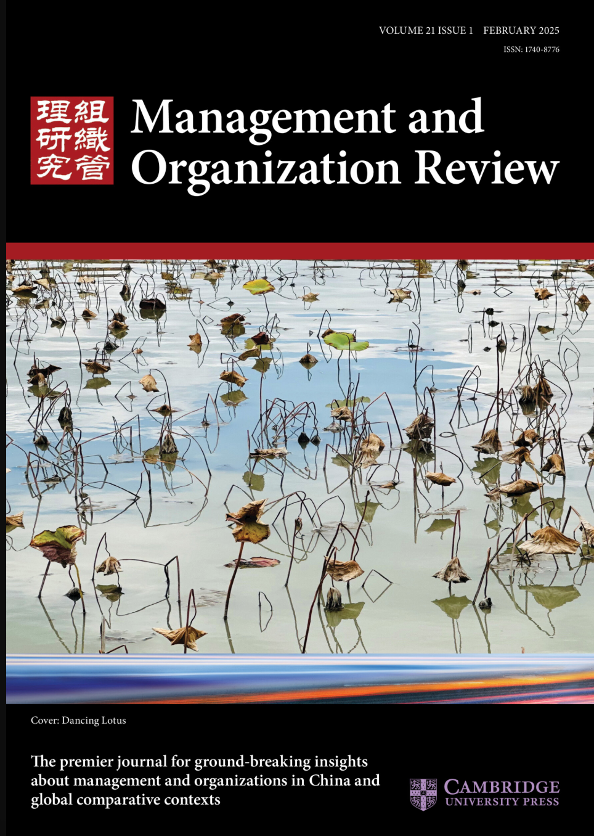主编来信|《组织管理研究》21.1新刊

Letter from the Editor
____________________________________________________________________________
‘More than half a century ago, G. William Skinner (1964) explored “What the study of China can do for social science”. His answer, in brief, was: A great deal, and in significant ways’. This is the opening sentence in the perspective paper by Zhou and Sui (2025), who have studied Chinese bureaucracy – the organizational apparatus of the Chinese government – for more than three decades. The authors recognize the significant role of the Chinese government in China’s rapid rise to the second-largest economy and ask, ‘How can organization theories benefit from what we have learned from research on Chinese bureaucracy’? They review and highlight major findings in three areas: agency problems and incentive provision; the use of social relations – guanxi – in policy implementation; and variable coupling among different parts of the bureaucracy. Viewing these three aspects as interrelated, the authors articulate their remarkable insights and suggest new research questions management scholars can explore to enrich organization theories. I hope you find these questions thought provoking and inspirational.
This issue also includes five articles that offer amazing findings on the research of social media, intellectual property protection, innovation, resilience, and Chinese outward foreign direct investment (ODFI). For example, Zhao, Park, and Luo (2025) take a stakeholder multiplicity perspective to theorize and empirically show that firms take more substantial responsibility when confronted with consumers’ social-media-based collective actions than when confronted with conventional channels of consumer complaints. This heightened responsibility stems mainly from collective actions’ tendency to spur law-enforcing agencies into addressing alleged firm misdeeds, demonstrating stakeholder multiplicity effect of social media empowerment. The authors also find that local governments’ bureaucratic capacity positively moderates collective actions’ effect on law-enforcing actions, somewhat echoing the points made in the perspective paper.
Meanwhile, Ge, Zeng, and Zhong (2025) study how a firms’ ESG signals impact its collaborate innovation with other firms. Using empirical data on A-share manufacturing companies listed in China from 2010-2021, they find that firms with higher ESG performance are likely to gain trust from potential external innovation collaborators, which increases their level of co-innovation in focal firms. Paying attention to innovaion at the individual level, Rong, Huang, Hao, Xie, and Li (2025) examine whether stronger copyright protection enhances the originality of short videos before and after the Campaign against Online Infringement and Piracy was implemented. Using representative samples on the Douyin Platform, the authors find this to be true due to the fact that external regulation tightening triggered enhanced intra-platform regulation. They also find that Douyin influencers exhibit a significantly more positive response to strengthened copyright protection than amateur creators.
Focusing on organizational resilience, Zhao, Lin, Liu and Gao (2025) conceptualize that vigilant managerial cognition – a cognition that supports managers’ awareness, detection, and precaution toward negative signals that may indicate future crises – is essential. They developed a textual index for this cognition using machine learning methods and analyzed a sample of Chinese enterprises. The results indicate that vigilant managerial cognition is indeed positively related to enterprise resilience, where the relationship is stronger in enterprises with more robust internal controls.
Finally, in a review paper examining the shift in patterns of Chinese OFDI from 1998–2023, Richert, Heim, and Kalyuzhnova (2025) theoretically distinguish between investments in natural resource-rich global regions such as Africa and Central Asia, and investments in technology-intensive regions such as Europe and North America, with regard to technology acquisition, creation, co-creation, and transfer. Based on a thorough analysis of 88 studies, the authors outline a three-cycle process that facilitates Chinese investment abroad: investment location decisions are influenced by the pursuit of competitive advantage (outcomes), which in turn rely on a combination of factors, including corporate objectives (motives), location characteristics (antecedents), and the complementarity between motives and antecedents (operational strategies). At the end, the authors identify several subthemes (e.g., control and learning mechanisms, technology transfer, intellectual property, etc.) for future research on Chinese OFDI.
I hope the collection of papers in this issue will inspire your interest in researching organization and management issues in the Chinese context and global comparable contexts. Thank you for your attention and support!

Xiao-Ping Chen
Editor-in-Chief, MOR
Perspective Article
Xueguang Zhou and Yuze Sui (23pp)
What Can the Research on Chinese Bureaucracy Do for Organization Theory?
Regular Articles
Meng Zhao, Seung Ho Park, and Lingli Luo (29pp)
How Social Media Empowers Stakeholders: A Stakeholder Multiplicity Perspective
Ke Rong, Jinglei Huang, Fei Hao, Danxia Xie, and Sali Li (23pp)
Copyright and Originality: Evidence from Short Video Creation in a Platform Market
Ge Ren, Ping Zeng, Xi Zhong
The Collaborative Innovation Effect of ESG Signals: Integrating Signaling and Trust Theories
Chen Zhao, Chen Lin, Yonghong Liu, and Zhonghua Gao
Effect of Executives’ Vigilant Managerial Cognition on Enterprise Resilience: A Natural Language Processing and Machine Learning Analysis
Maria Richert, Irina Heim, and Yelena Kalyuzhnova
A Systematic Literature Review of Chinese Investment in Natural Resource-Rich and Technology-Intensive Locations
——————————————————————————————————————–
Please note that full articles of MOR are accessible by paid members by logging into Dedicated Membership Area.
If you are not a paid member yet or your membership has expired, you are strongly encouraged to make the payment and enjoy membership benefits at the rate of USD 50 for student members and USD100 for regular members. Please click here for details.
